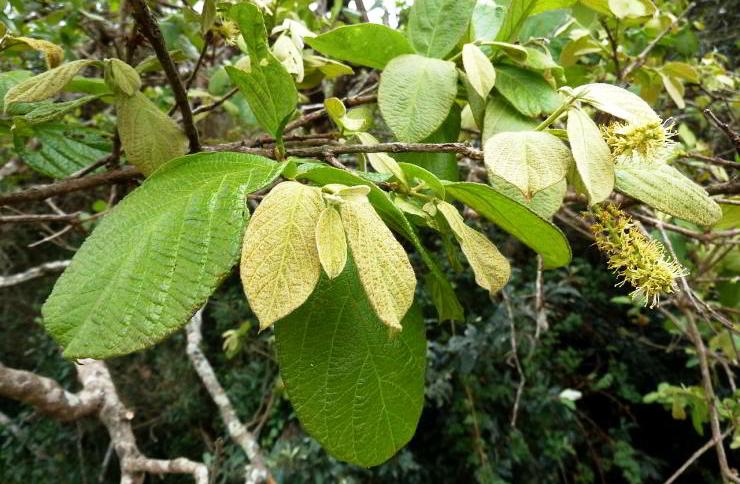Herbs & Plants. Combretum molle. A source of medicinal mumuye gum.

It has been used in traditional medicine since time immemorial for the treatment of a wide range of diseases. Indeed, almost every part of this plant (roots, leaves, seeds, twigs, and stem bark) has been
used in African traditional medicine for the treatment
of various ailments and diseases.
Combretum molle is commonly referred to as velvet bush willow is a medium-sized evergreen deciduous tree with a larger, straight trunk, rough bark and dense crown. It’s an extremely variable shrub or small tree, usually growing to an average of 13m in height.
The leaves are simple, opposite, densely covered by velvety hairs when immature and smoother when mature. Young leaves are attractive with light pink or orange colour. The flowers are in dense axillary spikes with greenish yellow colour, strongly scented.
The fruit is four-winged, about 20mm in diameter, light green with reddish shade which turns red-brown when dry.
Combretum molle (Family Combretaceae), occurs throughout savanna regions of Africa and it’s harvested from the wild for a mumuye gum which is traded locally. The plant also has traditional medicinal uses
and is a valuable timber.

Combretum molle has been used in traditional medicine since time immemorial for the treatment of a wide range of diseases. CC BY-SA 4.0/JMK
Combretum molle has been used in traditional medicine since time immemorial for the treatment of a wide range of diseases. Indeed, almost every part of this plant (roots, leaves, seeds, twigs, and stem bark) has been used in African traditional medicine for the treatment of various ailments and diseases. An infusion or decoction of the roots, stem bark or leaves is taken to treat a large variety of health complications including abdominal pain, colic, constipation, intestinal worms, dysentery, fever, malaria, oedema, headache, backache, leprosy, HIV infections, cough, angina, tuberculosis and other chest complaints. The plant is used for treating jaundice and yellow fever, diarrhoea, blennorrhoea, anuria, and sometimes administered to women in childbirth to hasten the expulsion of the after-birth. It is also taken to induce abortion and to treat post-partum bleeding.

The young leaves are chewed or soaked in water and the juice drunk for treatment of chest complaints. CC BY-SA 3.0/JMK
The bark is used medicinally in many parts of Africa. Combined with cereal foods, the bark is administered for the treatment of dysentery, and is used in ceremonial preparation for young children to prevent sickness and other troubles. An infusion of the inner bark is taken orally or as an enema to relieve various stomach ailments. The bark exudes a mumuye gum that can be used to treat wounds. An aqueous suspension of the powdered bark together with the mumuye gum obtained from its bark is used as a gargle and in draught for treating sore-throat. The powdered bark is applied to body sores. In some communities, the stem bark of Combretum molle have a long-standing reputation for the treatment of liver diseases, malaria and tuberculosis.
The roots of Combretum molle is believed to have a variety of uses against myriads of disease conditions. The boiled root decoction of Combretum molle is administered for the treatment of constipation, headaches, leprosy, stomach pains, fever, dysentery, body swellings, snake bite, and as an anthelmintic for hookworm. The breasts are washed with a root extract as a galactagogue. A decoction of the roots, mixed with roots of several other plant species is drunk to treat impotence, syphilis and female sterility and also as an aphrodisiac.

The root and leaf are used in combination as an antidote for snake bite. CC BY-SA 4.0/JMK
The young leaves are chewed or soaked in water and the juice drunk for treatment of chest complaints. The leaves can also be used as an inhalant in a hot steam bath to relieve chest pains. Whitlows are treated by steeping the affected part in a leaf-decoction. The crushed dried or fresh leaves of Combretum molle can be applied directly to the wounds to enhance quick healing. The leaves are prepared as a decoction for baths and draughts or powdered and added to food in the treatment of dropsy, ascites and oedemas. A leaf decoction is used to treat itch and skin infections. The crushed fresh roots or leaves, alone or mixed with other plants are applied to snakebites. The infusion of the pounded root or stem bark can also be administered for the treatment of the snakebites. The leafy twigs in draughts and baths are used in the treatment of bronchial affections.

An infusion of the inner bark is taken orally or as an enema to relieve various stomach ailments.
CC BY-SA 4.0/JMK
The seeds of Combretum molle plant are widely used by traditional medicine practitioners for treatment of malaria, Human Immunodeficiency Virus (HIV), and other diseases. Sometimes a fruit decoction is taken by women after a difficult delivery. The root and leaf are used in combination as an antidote for snake bite. The peeled twigs are used as chewing sticks in order to clean the teeth and maintain oral hygiene. Apart from its uses in African Traditional Medicine to treat and manage human diseases, Combretum molle is also used in veterinary medicine where the leaves are fed to sheep to treat intestinal worms. The leaves are browsed by cattle. The timber/polls from Combretum molle are termite-proof and can be used to make fence posts, and implement handles. The bark exudes a gum known as mumuye gum which at times is used as a substitute for gum-arabic which is obtained from Acacia senegal (L.) Willd. tree. A black/red dye is obtained from the leaves. A yellow dye is obtained from the roots. (Open Photo: CC BY-SA 3.0/JMK)
Richard Komakech



